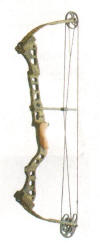Difference between revisions of "Compound bow"
From Cantr II Wiki
(spelling) |
|||
| Line 7: | Line 7: | ||
time=0.5| | time=0.5| | ||
resources=| | resources=| | ||
| − | objects=[[compound upper limb]]<br>[[compound lower limb]]<br>[[ | + | objects=[[compound upper limb]]<br>[[compound lower limb]]<br>[[riser]]<br>[[bowstring]]<br>2 [[cam]]s<br>[[cable]]| |
tools=[[bow square]]<br>{{hammer}}| | tools=[[bow square]]<br>{{hammer}}| | ||
machines=[[string jig]]| | machines=[[string jig]]| | ||
Revision as of 13:58, 2 January 2010
| ||||||||||||||||||||||
| ||||||||||||||||||||||
Description and uses
The compound bow is similar to the crossbow in the tools and machinery required but is less expensive, lighter and weaker. It is a good choice for a powerful weapon that doesn't use very much iron or steel.
Real-life context
Compound bows use a pulley system to enable the draw-weight (how hard it is to pull back the bowstring) to be minimised, or changed. With other bows, holding the bowstring taut makes the archer's muscles tired, reducing accuracy and sapping their strength. Thus, the major advantages of this bow are that it is easier to fire, and often more accurate.
Images

Image Source: Centenary Archers Club